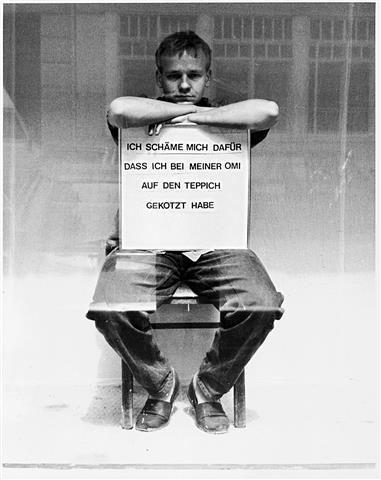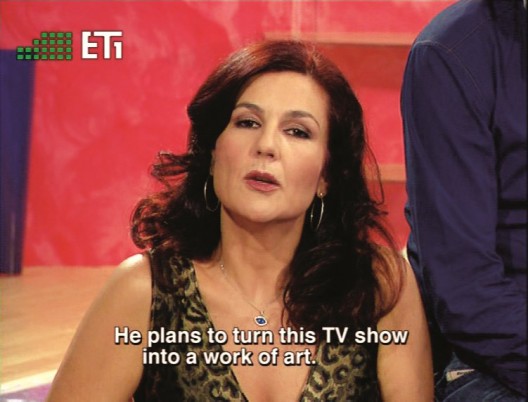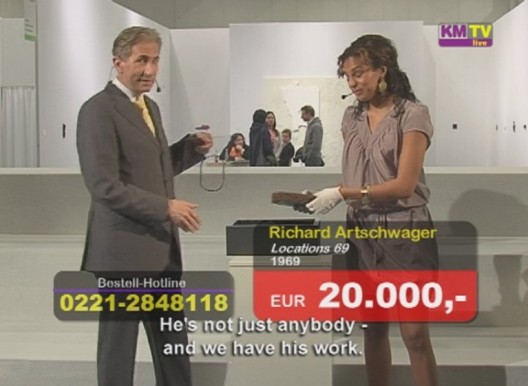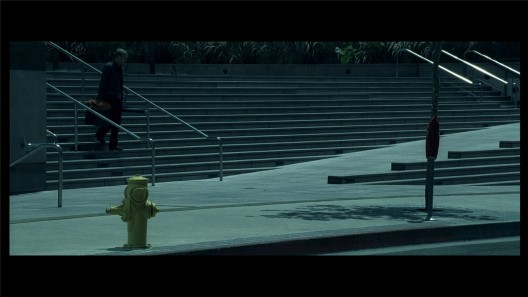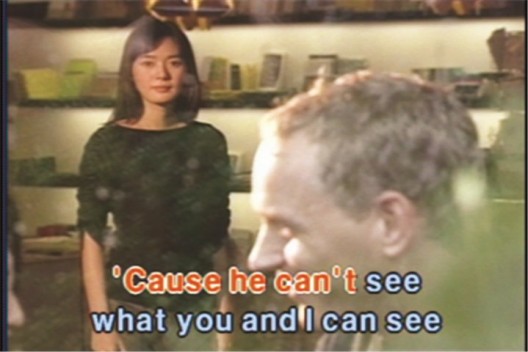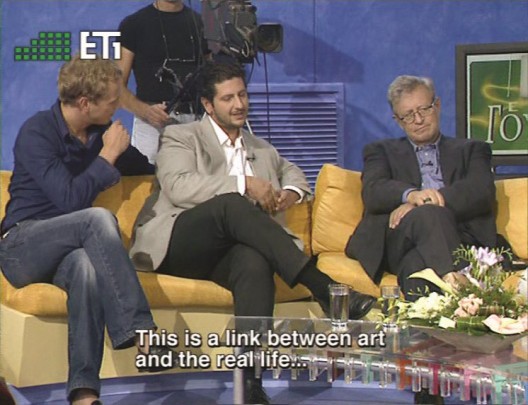This piece is included in Ran Dian’s print magazine, issue 2 (Winter 2015–2016)
Christian Jankowski (b. 1968) is an artist whose practice involves involving others in his practice, which includes sculpture, painting, installation, interventions, video—you name it. He is the son of Polish parents, which no doubt contributed to his sense of humor. He grew up in Göttingen, but apparently that didn’t hold him back. He is a professor at the Staatliche Akademie der Bildenden Künste Stuttgart but sensibly chose to live in Berlin. In December 2014, he was appointed curator of Manifesta 11, the European Biennial of Contemporary Art, which will be held in Zurich. Manifesta 10, curated by Kasper König, was held in St. Petersburg, and was the subject of some controversy due to Russian censorship laws and the events that unfolded in Ukraine.
Chris Moore: I was looking at the works you made for the exhibition in Stuttgart—“Dienstbesprechung” [Briefing]. Stuttgart is such a boring city—was that the reason for the title? Good grounding for a Manifesta?
Christian Jankowski: It has a lot to do with a Manifesta, yes. It’s very different, but it also puts focus on professions and the switching of professions and perspectives which are offered through different professional activities.
CM: Also, Manifesta has—fairly or unfairly—a reputation for not only being the biennial of Europe, but also the European Union Biennial, something very administrative.
CJ: It is, and it’s also the [biennial] where the profession of the curator has been looked into in great depth.
CM: It’s going to be the 100th anniversary of the Dada movement, and it’s based in Zurich, which is one of the centers of Dadaism. Often when people think of Dada, obviously the main protagonist is Duchamp. It’s an arguable case that he was a greater curator than artist. What’s the difference between being an artist and a curator (you are the first artist to curate Manifesta)?
CJ: For me, it’s a chance to play with another role. And it’s a great challenge, after twenty years doing my own projects, to think also about an experimental exhibition form and to link it with my own natural interests as an artist. I felt there is no way I can invent something that does not already exist in me. My interest always had, on one hand, a performative element; and on the other, [involved] reaching out to different audience groups that are normally outside the art world. I thought Zurich is a perfect space for me to do so. I wanted to reach out to companies that are in a way corporate, private or business spaces; for me, that could bring something new.
On the problem of curating for corporations . . .
CJ: I was involved in some “Kunst-am-Bau” [site specific] projects, for example, for an insurance company. But in the end I felt the discussion was lacking. None of the artists invited there did anything, because suddenly the bosses from the company would come by and say “Oh yeah, maybe we should do the same next year but get other new ideas”. I felt the discussion was quite secretive. If something like this happened in the Kunsthistorisches Museum, Vienna, journalists would write about it. Whereas here [with corporations] it is such a closed circuit that if the concept fails, it is not discussed further—there is not a third eye to judge and ask “What’s the problem?” It’s edited out instantly, because they have the money, they own the space and, of course, they have the last word.
CM: I am wondering whether biennials now can have the potential to be really provocative, because in one sense they are about entertainment and engaging with a public; on the other, there is this critical aspect. I’m wondering whether that critical aspect is now fundamentally flawed or whether the only way a biennial can be really provocative is not to be provocative, but to be controversial—is this the only way that a biennial can really cause a rupture?
CJ: I think that in the beginning, for this kind of experiment, they kind of get married, the artist and the host. If this communication hasn’t worked, this failure can be documented and then contemplated as a failure—or not. But I trust the artists that I choose are not only looking to this fun side. I think they will automatically look also for certain professions where they see it is possible to address this tension. I prefer problems that emerge in a one-to-one negotiation, where the ideas of the artists come in and then there is a response, and then this can develop. I feel it’s nicer that the problem has been created in the process. The start for these encounters should be neutral—you should [first] think everything is possible, and then ask, “Why isn’t everything possible?”
The artist is the core
For me, the core is always the artist—the artist is choosing the profession. We are working on a list now of all the professions working in Zurich. This will be used as a point of inspiration for invited artists, so that they can “cross” with a profession they are interested in, be close to and co-produce with it. All the professions come with certain ways of making use of art. And I think that’s an interesting point.
CM: You talk of the difficulties of reading not just Manifesta catalogues but lots of art catalogues—it’s the question of accessibility. So how accessible is Manifesta going to be?
CJ: This is similar to my work where I try to set up certain rules and structures in which one thing follows the next. Of course, it now has to be filled with the ideas of the artists and those people who are collaborating with them. But I’m also very inspired by things that you can sometimes describe in three or four sentences, where even people that have nothing to do with art can think it’s interesting. For example, maybe there is something to a private home which opens up like a public museum so that people walk through the living room to the bedroom and look at works. To me it’s very stimulating. This is maybe not how it is in institutions.
I don’t think all art must be visible, but that’s why this sort of work is being put in the third stage of the exhibition, which we call—a poetic name—the “Pavilion of Reflections”, to allow a way in which to mediate those micro works or those hidden works, or “idea” works that happen only for one second, which will then be transformed, with the help of media recordings, into something visible and discussable.
CM: Can it also fail?
CJ: If you work with two people, sometimes everything or nothing can happen, and if nothing happens, then there is also this “reality TV” moment of collision and questions. I would say that even a failed project doesn’t have to mean a failed Manifesta.
CM: Could you also talk about how you must address issues of language and culture—because there is a European audience containing different backgrounds, but there are also audiences beyond Europe who know of Manifesta but may only experience it via a newspaper article or something read online.
CJ: Yes, Sepake [Angiama] is Head of Education; I want to involve her more in the Pavilion of Reflections, because it is also a place where you can get a lot of information, and it’s the place where you see the satellites [events/exhibitions] in a mediated form. In the day time, people should walk round the satellite and then come in the evening and see something, or you might want to go the next day and get more information about the satellite shows you saw. But here there is also a question—I’m thinking about the Pavilion of Reflections and how it’s used, and being the way dOCUMENTA should be, and also to people who are not curators, and so on. I want a language and also questions, through the artists and also the whole of Zurich working on one project, that are not a difficult level to follow. I think it’s great that there are very direct questions—honest questions. Often, when you have established journalists as the moderators, then the host and even the artists switch onto a certain level to represent themselves. If there is suddenly a school class coming by and asking naïve questions, these are often the hardest to answer—and particularly in such a manner that your project is still represented in a complex way.
CM: Obviously the program is still being developed, but are there other projects that you can talk about?
CJ: There will be an exhibition consisting of existing work—even if it’s from last week. I have put this in three institutions: the Löwenbrau building complex [which includes Kunsthalle Zürich], the Helmhaus [a museum], and the Cabaret Voltaire. We will completely restructure the Cabaret Voltaire and turn it into the Zunfthaus der Künstler [guild house for artists], complete with the Cabaret der Künstler.
CM: This also references the early Dada movement.
CJ: Of course that’s part of it. We will also use this stage, which is this icon of Hugo Ball. This is the stage where people can come, and every artist—not only visual artists—is invited to come and be a club member of Cabaret der Künstler by submitting a project, which will follow the same concept of collaboration with another profession. So if you want to be part of it, you ask another profession, you give them performance instructions or you collaborate, and this person will be on stage performing it in a cabaret for ten, fifteen minutes. It is an open stage and it will run for 100 nights.
CM: So everyone can become a performer.
CJ: Yes! We will take Cabaret Voltaire apart, architecturally—we will make it something more secluded. And during the day it will be used for supporters of Manifesta.
CM: That’s interesting, because the cabaret is a kind of [in the spirit of the] joker—it’s like the jester in the medieval castle with the king. It’s about speaking the truth to power and making jokes about it and getting away with it because it is a joke, a song. This is also an opportunity, and a largely unscripted one, isn’t it?
CJ: It is, because we don’t know what we will get.
CM: Which is perhaps the most provocative thing of all…?
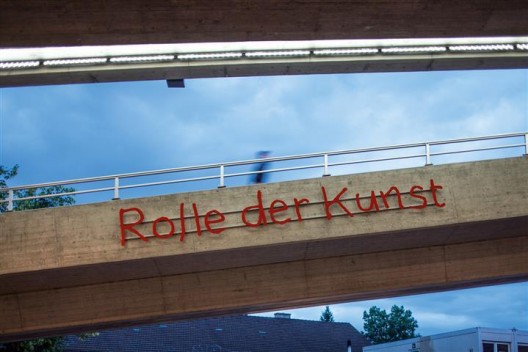
克里斯坦·扬可夫斯 基,《趾高气昂》, 清漆铝,尺寸可变, 2012 / Christian Jankowski, “The Grand Gesture”, varnished aluminum, dimensions variable, 2012
CJ: Yes! [Laughs] The other part is that we will invite on stage musicians and fashion designers, too, and people who are trained to be members of a circus, or anyone you might consider an artist. Everybody can submit these performances for other people who are in certain professions.
I’m not going to put my own work on show, but of course this deals with all my interests and is also informed by what I stand for as an artist. I described earlier a kind of win/win situation—there’s nothing against that. I also think the Manifesta exhibition would win a certain extra point if a few people could see it also as an art work. It wouldn’t mean that it’s bad. For me, there are other examples of artists curating shows that you feel are rather like freak shows—they misused people in their positions.
If this is a good exhibition people will say “Oh, Jankowski was the curator and it’s an ok show”, and then I’ll be happy; and if some people ask “Aha, hm, is this also an experimental exhibition form that has a lot to do with him—a massive sculpture or performance?”, then I am also fine with that—if it stimulates the thoughts you can have about the exhibition.
Notes
1. In 1986 Jan Hoet (1936-2014) curated “Chambres d’Amis” (Guest Rooms), in which some 50 American and European artists were invited to create works for 50 private homes in Ghent that were then opened to the public for several weeks. Hoet was founder and curator of S.M.A.K. (Stedelijk Museum voor Actuele Kunst or Municipal Museum for Contemporary Art) from 1975 until his retirement in 2003. He also curated dOCUMENTA IX in Kassel (1992).
2. Cabaret Voltaire was the name of a nightclub founded by Hugo Ball (1886-1927), with his companion Emmy Hennings (1885-1948) on February 1, 1916 as a cabaret for artistic and political purposes. Other founding members included the Surrealist poet Tristan Tzara (1896-1963) and artists Sophie Taeuber-Arp (1889-1943) and Jean Arp (1886-1966).




